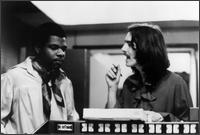 LAHAINA -- A final piece of Lahaina’s sugar-milling history fell with a bang heard around the historic town on Saturday afternoon as a series of precision explosions toppled a 90-foot-tall Pioneer Mill boiler building along Lahainaluna Road.Well...it finally happened. Most of us from The Time Machine Crew grew up and spent our lives around the agricultural world of sugar. Playing in cane fields during our youth (Okay - maybe some of us still play in canefields...but please don't tell anyone.) and driving by the sugar mill on a daily basis from the sleepy old Lahaina village to the "hustle and bustle" massive tourist destination that it is today. We were out of town in April to come back and find that one side of the road had the sugar mill demolished with only the towering smokestack left as a Lahaina landmark. Yesterday, on the other side of Lahainaluna Road, the remaining portion of the industrial age came down. We knew this was coming for a long time but it still gives us pause for a moment of reflection.
LAHAINA -- A final piece of Lahaina’s sugar-milling history fell with a bang heard around the historic town on Saturday afternoon as a series of precision explosions toppled a 90-foot-tall Pioneer Mill boiler building along Lahainaluna Road.Well...it finally happened. Most of us from The Time Machine Crew grew up and spent our lives around the agricultural world of sugar. Playing in cane fields during our youth (Okay - maybe some of us still play in canefields...but please don't tell anyone.) and driving by the sugar mill on a daily basis from the sleepy old Lahaina village to the "hustle and bustle" massive tourist destination that it is today. We were out of town in April to come back and find that one side of the road had the sugar mill demolished with only the towering smokestack left as a Lahaina landmark. Yesterday, on the other side of Lahainaluna Road, the remaining portion of the industrial age came down. We knew this was coming for a long time but it still gives us pause for a moment of reflection.Below is a story that appeared in The Maui News from staff writer MATTHEW THAYER:
What A Blast
By MATTHEW THAYER, Staff Writer
LAHAINA -- A final piece of Lahaina’s sugar-milling history fell with a bang heard around the historic town on Saturday afternoon as a series of precision explosions toppled a 90-foot-tall Pioneer Mill boiler building along Lahainaluna Road.
The structure will be the last to come down in the demolition of the mill that served the plantation founded in 1860 and closed in 1999. The boiler building was built about 40 years ago and once was connected to the mill by way of a conveyor bridge that spanned Lahainaluna Road. Conveyor belts delivered bagasse, the cane fibers wrung of sugar, to fuel the boilers that produced steam. The steam was used for a variety of purposes throughout the mill, including turning turbines to make electricity.
Saturday’s demolition was coordinated by Stacey Loi-zeaux, a Baltimore woman whose family has been using explosives to bring down structures for three generations. The family company, Controlled Demolition Inc., has handled many jobs far larger than the Pioneer Mill boiler, including the Seattle Kingdome, Pittsburgh’s Three Rivers Stadium and First Hawaiian Bank in Honolulu. Loizeaux said the family also has handled nearly every big demolition in Las Vegas.
Loizeaux said Pioneer’s boiler building, basically all steel beams, pipes and sheet metal siding, presented a very basic challenge. She and her crew had to force the parts to fall away from the street and nearby houses, while bringing them down to a level where demolition crews could use excavators equipped with heavy “shears” to cut them apart.
Loizeaux said the Pioneer Mill takedown required about 30 pounds of RDX explosive in linear shaped charges. The charges deliver three million pounds of pressure per square inch, directed so precisely that the building’s steel beams look-ed as if they had been cut with a torch.
“The charges are designed to cut steel,” she said. “They go through it like a knife through butter.”
The charges were arranged at three different levels of the building. Each charge was wrapped with a flexible cocoon made of everyday materials, even mill conveyor belts saved for that specific purpose. Loi-zeaux said the charges were covered with plywood, conveyor belt, geotextile fabric and chain-link fence. The wrapping is designed to contain shrapnel and debris.
About 100 people gathered at the former mill site to watch the blast from a designated area about a quarter mile away from the boiler room. Loizeaux was stationed well on the other side of the boiler, sheltering behind a shipping container. She said she would not be able to see the boiler as she activated the blast with an arming device.
When all was ready, at about 12:40 p.m., firetruck and police car sirens signaled the alarm. About a minute later, one of Loizeaux’s co-workers counted down from 10 for the benefit of people watching from near one of the plantation’s old Quonset huts. At the count of 10, a series of four explosions rocked the structure and destabilized it for the killing blows to come. Six seconds later, as planned, another four blasts brought the building down like a falling tree. With birds flying out of the structure as if their lives depended on it, and dust billowing like smoke, the boiler building crumpled right where Loizeaux said it would.
“This was the easiest and cheapest way to get this down to a workable level,” Loizeaux said.
The sound of the explosions lured the curious from around town to investigate what the commotion was about.
“I heard it at Foodland,” said one boy who sat on his bike and watched an excavator operator begin tearing at the remains of the fallen building.
There were mixed feelings among the people watching. Some found it exciting and others saw it as the end of an era.
“I think it’s a really sad time for the people of Lahaina,” said Darleen Franzen, who moved to Lahaina from Keanae. “That felt really sad.”
Princess Nahienaena Elementary School 4th-grader Brandon Rabara, 10, said the spectacle took his breath away.
“I thought it was cool and loud,” Rabara said. “It made my heart stop.”
Retired Pioneer Mill truck driver Hans Michel said the demolition of the boilers made final what started back in 1999, when a long line of trucks and vehicles escorted the last load of cane into the mill to be processed.
“It’s kind of sad because it’s all gone,” Michel said. “Actually, I felt more sad when the mill closed. When we came in with the last trucks to the mill, when it closed, that was very sad. You put all the work into there.”
Michel said he’s glad the 200-foot-tall Pioneer Mill smokestack is to be preserved. The landmark that guides fishermen and boaters back to Lahaina Harbor also helps him find his way home.
“Lucky we’ve got the smokestack yet. Now you go up Lahainaluna and your first impression is, you wonder if you are in the right place. You almost wonder if you made a wrong turn.”
The Time Machine's own Alison chimes in:
This is the first I've heard about it. It makes me SICK. Lahaina is being destroyed. They are paving paradise and putting up parking lots. I wish I had a picture of it from the 70's. I'll always remember the 12:00 whistle, the horrible smell, and being intrigued to peek inside when driving past and wishing I got to see the secrets of the mill the way Lynn's dad did. It is one of those landmarks I assumed would always be there. I've been wrong about assuming things.
I found an old Maui Surf pen the other day. It doesn't work, but I couldn't throw it out. (yes, I do still have pack rat tendencies). I remember getting banana ice cream there for the first time with Diana Reeves. I too, miss shave ice at Yamamoto Store and a night out with my family at Morikawa's where I would order grilled cheese. PLAIN grilled cheese.
I remember sitting at Shop Suey drinking chocolate milk from a little carton bought at Yamamoto Store with 7 paper straws... waiting for 5:00 when my mom would close shop and bring me home. I remember riding my bike with my dad to Hop Wo bakery for fresh baked bread, and remember getting my best haircuts at Michael's in the rickety old building on the ocean side of front street listening to the ocean and watching rainbows reflected from crystals dance around the room. Then I would go outside and buy a gold charm for my necklace. I still have my artist's pallet, and my roller skate with moving wheels...
I'm sounding like an "old person", but I think we have the best memories of Lahaina and no matter how much "they" get joy from describing in detail how they put explosives into an old historic landmark, thankfully they can never take the memories we have inside of us. I miss the cane fields, the "road" I would meet Lynn at, Craft's drugs, and Nashiwa Bakery's dobash cakes. I could talk for hours with you guys if we had a checker board and a tree and a shopping center to sit at. Thanks for being my old friends. It means a lot. I miss you.
...and now on to even "older" friends... The following can be found at the website Pioneer Mill Company: A Maui Sugar Plantation Legacy from the College of Social Sciences Center For Oral History - University of Hawaii at Manoa.Pioneer Mill Company, located on Maui’s west side, was founded in 1860. It was one of Hawai‘i’s last remaining sugar plantations at the time of its closure in 1999. By 2002, the abandoned mill, fallow fields, and plantation-era homes seemed to be all that remained of the sugar company’s once-dominant influence on West Maui life.
Plantation camps, developed to house workers and their families, were once scattered among the cane fields from Olowalu to Honokohau. Modern subdivisions now stand on these lands. Nearby Lahaina, the Hawaiian Islands’ former capital, served plantation residents as West Maui’s center of commerce and entertainment.
While Lahaina and the surrounding area are expanding tourist destinations, the mill, fields, and camp lands are reminders of an earlier era, as recalled by the area’s longtime residents, whose stories compose this oral history project.
“I [started working] for Pioneer Mill [Company] when I was fourteen years old. Outside [in the] field, cut grass. All of us. Mr. [John T.] Moir told our teacher that whoever likes to work out in the field to apply for the job. [I made] thirty cents a day. I gave [my pay] to my mother. You know what, when I ask her, ‘Can I have some money that I earned?’ She say, ‘Okay.’ She put down my money and say, ‘This is for your clothing, this is for your food, this is for your shoes.’ Was left nothing. (Laughs.)” —Theresa Delos Reyes, former Pu‘ukoli‘i Camp resident
“You want to work in the mill, there’s welding, there’s electrical work, there’s everything you can think of in the mill. And there’s carpenter shop, there’s tractor shop, mechanical shop. You name it, the plantation had. Every field that you want to learn. And sometimes it depends on the individual, too. If you like to learn, you got to accept some of the conditions, yeah. . . . Sometimes when you doing a mistake or don’t like take orders and stuff like that, sometimes you deprive yourself of learning little bit more.” —Anthony Vierra, former Lunaville resident; Pioneer Mill Co. cane truck driver
The interviews document the social history of West Maui’s Pioneer Mill sugar plantation. They illustrate the range of lifestyles, work experiences, and values associated with Hawai‘i’s plantation era.
“The best part about swimming was when the navy boats, or marine boats, or whatever boats come in, they line up at the pier. Where the Pioneer Inn hotel was, in front, the wharf there. They would come in, and we would dive for quarters, whatever they throw in the water, we would dive for it. That would be during the summertime that they would come. And whatever we collect, time to go home, we would go to the shave ice store called Yamamoto Store. And we would buy shave ice with the money. On our way home, the same time, we would go to the Morikawa Restaurant. We would buy noodles. The nickname for that is ‘fry soup.’ But the noodles, you know, is [actually] chow fun. You know, the fat [noodles]. They would [serve] it in a [paper] cone-like thing. The cheapest one was five cents, fifteen cents, and then the quarter one was the big one. And the Morikawa family restaurant was famous for that.” —Ben Bedoya, former Mill Camp resident
They also represent the plantation residents’ personal recollections of West Maui’s past and their views on the island’s post-sugar social, political, and economic future.
“As far as living in Pu‘ukoli‘i, Pu‘ukoli‘i was a big camp, plantation camp, you know, owned by the Pioneer Mill Company. We rented our homes from Pioneer Mill. And, well, growing up in a camp like that was fun because there were about, I would say, about maybe two hundred families with many children. All the families had about six, seven, eight, nine children so, you know, we had plenty playmates. So growing up was enjoyable.” —James Higuchi
“The future of Lahaina is not my time. I’ll be gone by then. But this area over here, all around Maui, millionaires, multi-millionaires will be owning land over here. And their summer vacation or winter vacation will be over here, whichever they choose. And the only jobs available will be working at the hotel or servicing the people living up here, the rich guys. That’s the only two types of work. No agriculture, no nothing else. You going be working for them. So the local guys going be struggling along.” —Donald Rickard, Kelawea Camp resident; Pioneer Mill Co. crane operator; International Longshoremen’s and Warehousemen’s Union business agent
The transcripts of these oral histories are deposited in libraries throughout the state. It is hoped these oral histories will inspire and inform landowners, planners, and West Maui residents as they struggle to determine use of the former sugarcane lands.
Interviewees
Bedoya, Ben, Mill Camp resident; sugar field worker, soldier, supply manager
Delos Reyes, Theresa, Pu‘ukoli‘i Camp resident; sugar field worker
Fujii, Doris Ige, Keawe Camp resident; sugar field worker, pineapple cannery worker, waitress
Fujii, Harumi, Keawe Camp resident; sugar field worker, carpenter, tractor operator, welder, credit union manager
Hashimoto, Myrtle Tamura, Lahainaluna Road resident; clerk typist
Hayashida, Sueto, Keawe Camp resident; luna (overseer), plantation store employee, plumber
Higuchi, James, Pu‘ukoli‘i Camp resident; sugar field worker, dairy worker, office worker
Hinahara, Minoru, Crater Camp resident; contract cane grower, carpenter, soldier, tractor and truck driver, contractor
Hussey, Edward, Homestead resident; irrigation supervisor, coordinator/department head
Kadotani, Sam S., Ka‘anapali Landing resident; fish seller, office worker
Kimura, Amy Kiyota, Mill Camp resident; maid, state worker
Kiyota, Allen, Mill Camp resident; soldier, radar operator, circuit designer, custodian/bus driver
Kiyota, Trudy, Mill Camp resident; teacher
Kuboyama, Kazukiyo “Jiggs,” Kelawea Camp resident; welder’s helper, carpenter, soldier, teacher
Rickard, Donald, Kuhua Camp and Kelawea Camp resident; sugar field worker, luna, crane operator, power plant boiler, union agent
Sodetani, Susumu “Peanut,” Waine‘e Camp resident; rodman, carpenter, steam plow operator, blacksmith, defense worker, centrifugal operator, oiler, manintenance worker
Vierra, Anthony, Lunaville Camp resident; soldier, shipyard worker, luna, truck driver, parks worker
Interviewers
Nishimoto, Warren, COH director
Orr, Maria, researcher-interviewer
Yamada, Holly, research associate

















































 ">
">












































































































































































































































































































